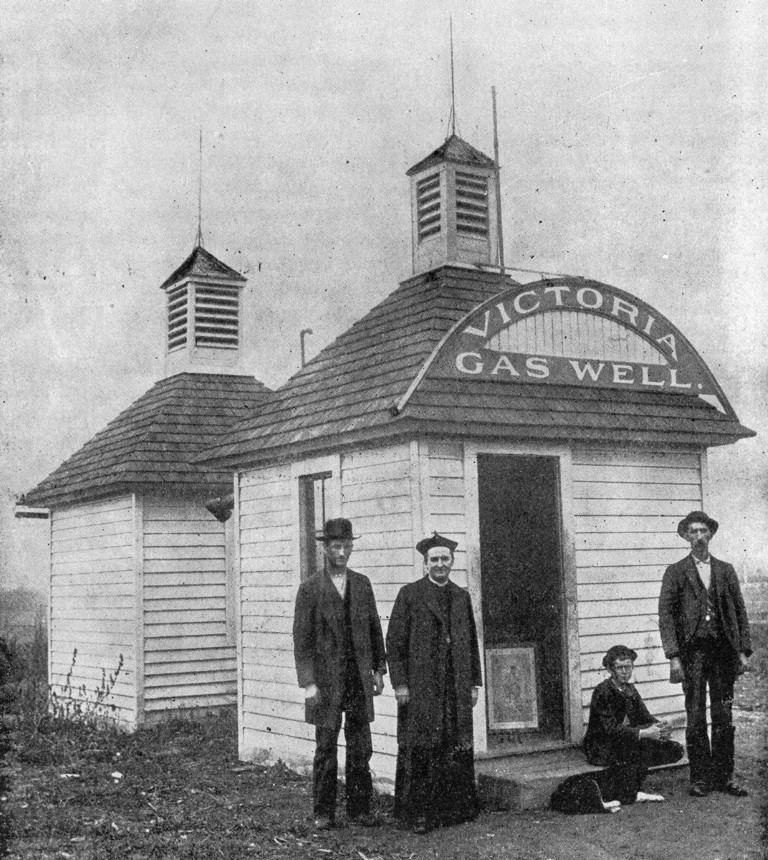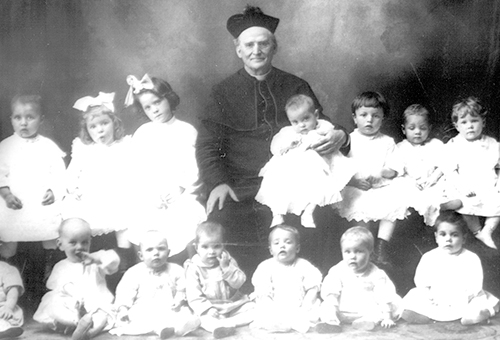"A City of Charity"
Father Baker was surprised by his first priestly assignment -- he was appointed assistant superintendent at Limestone Hill under his old friend, Father Hines. The Bishop of Buffalo wanted Nelson there because of his business sense and organizational ability.
When Father Baker arrived in 1876, St. John's Protectory (a facility that housed older boys who were considered “willful and truant”) and St. Joseph Boys' Orphan Asylum (for younger orphans) had a combined debt of $27,000. Although he was eminently qualified to help, Father Hines was all too often unwilling to make the drastic changes that were needed. By 1881, the debt had risen to more than $60,000 -- a figure equivalent to more than $1.8 million today!
Frustrated and thinking the situation hopeless, Father Baker asked for, and was granted, a transfer to St. Mary’s Parish in Corning, N.Y. After one year there, though, he was summoned to return to Limestone Hill as Father Hines' replacement. The elder priest had grown ill and was forced to retire.
Though he was concerned about the substantial problems facing him at Limestone Hill, Father Baker jumped into his new assignment with enthusiasm. Immediately he was confronted by several creditors who were owed large sums of money. He was blunt. He asked them if they would be willing to take partial payment now and wait for the rest. All but one refused the offer. He then drove to the bank that held his personal savings and withdrew every penny he had to his name to pay off the debts. The situation had improved…for now.
A Mind for Innovation
 Realizing he needed a more permanent solution, Father Baker got the idea to form the Association of Our Lady of Victory, a fundraising initiative that would transform his organization forever. Every evening, he sat down and wrote letters to postmasters all over the country asking them to send him names of charitable, Catholic women in their cities and towns. As these names came in, he then wrote to these ladies, appealing to their sense of charity on behalf of the boys in his care. He asked for one quarter a year in membership dues.
Realizing he needed a more permanent solution, Father Baker got the idea to form the Association of Our Lady of Victory, a fundraising initiative that would transform his organization forever. Every evening, he sat down and wrote letters to postmasters all over the country asking them to send him names of charitable, Catholic women in their cities and towns. As these names came in, he then wrote to these ladies, appealing to their sense of charity on behalf of the boys in his care. He asked for one quarter a year in membership dues.
The Association was an unqualified success! In a few years' time, not only did Father Baker pay off his debts, but he was able to begin much-needed building projects — a new, larger chapel and additions to the protectory and orphanage.
During the early 1890s, natural gas had been discovered in the region. Late one evening, as Father Baker sat in his office paying the enormous heating bills for his institutions, his thoughts turned to the possibility of drilling for gas on the property. Soon after, Father Baker approached the Bishop about the idea, seeking a loan to start the project. He reluctantly agreed.
Several weeks after drilling had started, nothing was happening. Community residents began to get restless and referred to the project as "Father Baker's Folly." Money was running out and Father Baker’s assistants pleaded with him to stop. Undeterred, work continued. Finally, at an unheard-of depth of 1,137 feet, a pocket of gas, dubbed "Victoria Well," came in! The pool struck that day yielded enough natural gas to heat all of Father Baker's buildings, provide gas for cooking and to even heat the homes of about 50 families who lived nearby. Amazingly, the well is still producing today … albeit in a very modest amount.
A “City of Charity”
Around the turn of the 20th century, Father Baker was horrified to learn that bones and bodies of infants and small children were being found as work was carried out dredging sections of the Erie Canal. The supposition was that unmarried women who had given birth or had been banished from their homes threw their newborns into the canal to drown, thereby ridding themselves of the burden of raising him or her and restoring their family’s dignity. Horrified and called to immediate action, Father Baker set his will to a new project.
 When completed, OLV Infant Home would provide a sanctuary for unwed mothers and their babies. Anyone was welcome and no questions were asked -- if a mother did not want to keep her infant, there was a crib and a blanket always set next to the unlocked door of the home, so she could deposit her child there during the night. Many of the locals disapproved of the situation, saying that these mothers needed to "pay" for their immorality by having to live and raise their children in poverty. Naturally, Father had no patience for such hard-heartedness.
When completed, OLV Infant Home would provide a sanctuary for unwed mothers and their babies. Anyone was welcome and no questions were asked -- if a mother did not want to keep her infant, there was a crib and a blanket always set next to the unlocked door of the home, so she could deposit her child there during the night. Many of the locals disapproved of the situation, saying that these mothers needed to "pay" for their immorality by having to live and raise their children in poverty. Naturally, Father had no patience for such hard-heartedness.
After construction was completed in 1908, and the facility was quickly filled, it became one of Father Baker's favorite places. His nightly rounds always ended at the Infant Home where he was often found tucking in little ones, blessing them on his way out the door.
The addition of the Infant Home completed Father Baker’s vision of an organization that provided services to needy children throughout their formative years – from birth up to adulthood. Those without hope could be born at “Father Baker’s”, raised and educated, taught a trade and sent out into the world as hopeful, well-rounded individuals.
Thanks to his ingenuity, his partnership with the Blessed Mother, and his generous benefactors throughout the U.S., his “City of Charity” continued to grow in size. New sections were frequently added to the older protectory and orphanage buildings to make room for the constant influx of needy children and teens. The next large-scale building project, though, was the addition of a maternity hospital that was completed in 1919. A grander vision loomed…


